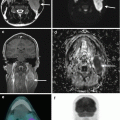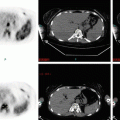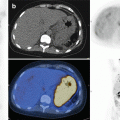Uptake
Score
No uptake
1
Uptake less than or equal to the mediastinum
2
Uptake greater than the mediastinum but less than or equal to the liver
3
Uptake moderately greater than the liver
4
Uptake markedly greater than the liver and/or new lesions
5
Areas of uptake which are likely secondary to incidental, inflammatory or infectious pathology
X
For interim scans a substantial but incomplete reduction in metabolic activity may be sufficient to indicate an adequate response to treatment. The optimum threshold for interpreting interim PET scans depends on expected patient prognosis and proposed escalation or de-escalation of treatment. In particular, where standard treatment is omitted on the basis of a negative interim PET (e.g. fewer cycles of chemotherapy and or no radiotherapy), a lower threshold of positivity, using a score of 3, is recommended to prevent possibility of under treatment.
Both positive and negative results at end of treatment need to be considered in the light of the inherent limitations of FDG PET imaging. Infection and inflammatory uptake can lead to more intense false-positive scans of 4 or more. Positive scans should therefore, wherever possible, be confirmed with histology prior to subjecting patients to treatment escalation. If it is not possible or practical to obtain histology, follow-up imaging following adequate treatment for any reversible benign causes of uptake, e.g. infection, may be helpful in supporting detection of residual disease. Finally, a negative PET scan cannot exclude the presence of residual microscopic disease which is especially relevant in considering whether patients should undergo radiotherapy following chemotherapy.
Key Points
PET/CT should be performed as part of staging, is more accurate than CECT and precludes the need for routine bone marrow biopsy.
Interim PET is an accurate predictor of end of treatment status and progression-free survival.
Multiple prospective trials are assessing response-adapted therapy based on interim PET. The results of several completed studies have shown encouraging results indicating that escalating or de-escalating treatment based on interim PET can improve outcome or reduce toxicity.
The 5-point Deauville score has been well established in clinical trials and now forms the basis of response assessment description in HL in all clinical reports.
Deauville 1 and 2 represent CMR, and Deauville 3 also most likely represents CMR in the context of standard treatment.
EOT PET is the determinant of curative treatment and provides useful prognostic information.
For interim PET the optimum cut-off for a positive PET scan depends on the intended management. A lower threshold of Deauville 3 is more appropriate if standard treatment, e.g. radiotherapy or further chemotherapy cycles, will be omitted on the basis of a negative scan.
References
1.
Hutchings M. How does PET/CT help in selecting therapy for patients with Hodgkin lymphoma? Hematology Am Soc Hematol Educ Program. 2012;2012:322–7.PubMed
2.
3.
4.
Barrington SF, Mikhaeel NG, Kostakoglu L, et al. Role of imaging in the staging and response assessment of lymphoma: consensus of the International Conference on Malignant Lymphomas Imaging Working Group. J Clin Oncol. 2014;32(27):3048–58.CrossrefPubMedPubMedCentral
Stay updated, free articles. Join our Telegram channel

Full access? Get Clinical Tree







